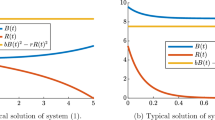Abstract
In this research, we try to improve Bracken's and Chen's work to significantly better fit our extended Lanchester model into the Ardennes Campaign live data. Essentially, we adopt the concepts of the tactical factor variable and the shift time variable to improve the original Lanchester's model. Moreover, we use the Lanchester square law model instead of Lanchester linear law model to reflect the fact that the Ardennes Campaign was not an indirect-fire but a direct-fire combat. According to our numerical experimental result, we improved Bracken's work by 39.26%, and Chen's work by 19.51%. The contribution of this research is that we propose a much better qualitative analysis model for the explanation of modern combat.
Similar content being viewed by others
References
Lanchester FW (1916). Aircraft in Warfare: The Dawn of the Fourth Arm. Constable: London.
Bracken J (1995). Lanchester models of Ardennes Campaign. Nav Res Log 42: 559–577.
Chen PS and Chu P (2001). Applying Lanchester's linear law to model the Ardennes Campaign. Nav Res Log 48: 653–661.
Engel JH (1954). A verification of Lanchester's law. Opns Res 2: 163–171.
Samz RW (1972). Some comments on Engel's: a verification of Lanchester's law. Opns Res 20: 49–52.
Helmbold RL (1994). Direct and inverse solution of the Lanchester square law with general reinforcement schedules. Eur J Opl Res 77: 486–495.
Chase JV (1988). A Mathematical Investigation of the Effect of Superiority of Force in Combats upon the Sea, 1902 (reprinted in Fiske BA, The Navy as a Fighting Machine. US Naval Institute Press: Annapolis, MD).
Osipov M (1991). The Influence of the Numerical Strength of Engaged Forces on their Casualties, Military Collection, Volume 3–7, 1915 (translated by Dr Helmbold RL and Dr Rehm AS, USACAA: Bethesda, MD).
Osipov M (1995). The influence of the numerical strength of engaged forces on their casualties. Nav Res Log 42: 435–490.
Taylor JG (1983). Lanchester Models of Warfare (two volumes): Operations Research Society of America: Arlington, VA, USA.
Morse PM and Kimball GE (1951). Methods of Operations Research. Wiley: New York.
Deitchman SJ (1962). A Lanchester model of guerrilla warfare. Opns Res 10: 818–827.
Maybee JS (1985). The theory of combined-arms Lanchester-type models of warfare. Nav Res Log Quart 32: 225–237.
Helmbold RL (1979). Some observations on the choice of exponents in Lanchester's law. Unpublished.
Hartley DS (1991). Confirming the Lanchestrain linear-logarithmic model of attrition. Martin Marietta Energy Systems Inc., K/DSRD-263/R1, Oak Ridge, TN.
Data Memory Systems Inc (1989). The Ardennes Campaign simulation data base (A CSDB), Phase II Final Report.
Fricker Jr RD (1998). Attrition model of the Ardennes Campaign. Nav Res Log 45: 1–22.
Chu P and Chen PS (2000). A simple method to fit the Lanchester's linear model for Ardennes Campaign. J Inform Optim Sci 21: 421–427.
Wiper MP, Pettit LI and Young KDS (2000). Bayesian inference for a Lanchester type combat model. Nav Res Log 47: 541–558.
Hausken K and Moxnes JF (2002). Stochastic conditional and unconditional warfare. Eur J Opl Res 140: 61–87.
Author information
Authors and Affiliations
Appendix A: Proof of Proposition 1
Appendix A: Proof of Proposition 1
First we compute ∂SSE k /∂a, ∂SSE k /∂b and ∂SSE k /∂d



Second we solve the critical points of SSE k (a, b, d).
By Equations (A.1), (A.2) and (A.3), with notation of g(i, k), we know that



If we substitute the expressions for a and b from Equations (A.4) and (A.5) into Equation (A.6), then we get an equation in d only. That equation can be written as

We now consider the positive roots of Equation (A.7). Let f(d)=∑j=06θ
j
d2j. From θ6>0, we have that  . On the other hand, we know that f(0)=θ0<0. Since f(d) is a continuous function, we deduce that f(d) has positive roots.
. On the other hand, we know that f(0)=θ0<0. Since f(d) is a continuous function, we deduce that f(d) has positive roots.
Rights and permissions
About this article
Cite this article
Hung, CY., Yang, G., Deng, P. et al. Fitting Lanchester's square law to the Ardennes Campaign. J Oper Res Soc 56, 942–946 (2005). https://doi.org/10.1057/palgrave.jors.2601878
Received:
Accepted:
Published:
Issue Date:
DOI: https://doi.org/10.1057/palgrave.jors.2601878




